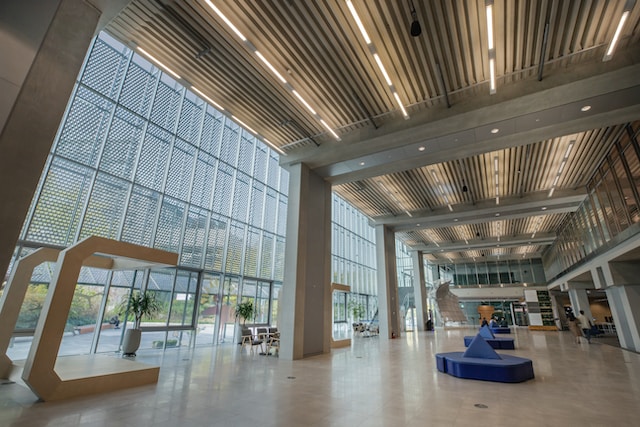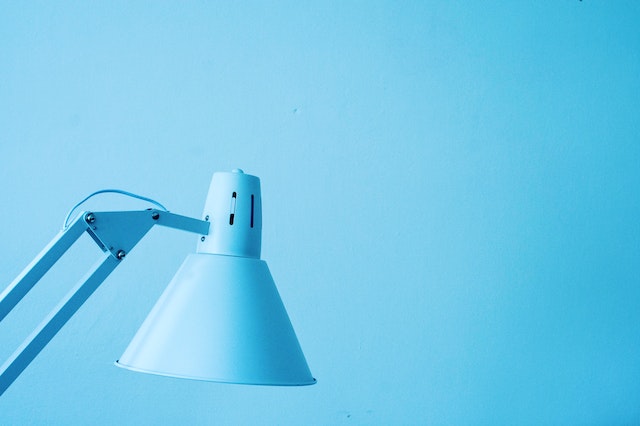
The contemporary workspace is not merely a place where tasks are executed; it is an environment where creativity flourishes, ideas merge, and productivity thrives. The importance of the office environment in fostering productivity is an intricate web of factors, many of which are often overlooked. Among them, the role of lighting and office lights stands towards the top. The right lighting doesn’t just illuminate a room; it sets the tone, mood, and energy of a workspace. A well-lit office can boost morale, reduce fatigue, and significantly enhance efficiency. It’s not merely a matter of aesthetics, but a critical aspect affecting the wellbeing and productivity of employees.
Understanding the role of lighting in the workplace goes beyond the selection of bulbs and fixtures. It’s about creating a harmonious working space, where light complements the work, whether in a bustling coworking environment or a serene private suite. In the UK, where the blend of tradition and modernity often reflects in architectural designs, the challenge and opportunity lie in integrating lighting solutions that enhance rather than impede the workflow. This post aims to explore the best office lighting strategies for employee productivity, considering the unique characteristics of various office solutions provided by London Office Space, and aligning them with the specific regulations and trends within the UK market. It’s a journey towards creating a brighter, more productive future for your office space.
Understanding the Connection Between Lighting and Productivity
The Science Behind Light and Human Behaviour
Lighting is not merely a utilitarian component of office design; it’s a deeply rooted part of the human experience that has profound effects on behaviour and performance. Scientific studies have illuminated the ways in which different light frequencies and intensities influence the circadian rhythm, our internal biological clock that regulates sleep, wakefulness, and energy levels. Proper lighting that aligns with natural daylight patterns can positively affect focus, mood, and overall efficiency. On the other hand, poor or inappropriate lighting can lead to eyestrain, headaches, fatigue, and reduced concentration. In the context of the UK’s diverse and ever-changing weather conditions, integrating lighting that simulates natural light becomes a pivotal aspect of office design.
Impact of Proper Lighting on Employee Health and Wellbeing
The wellbeing of employees is not just a matter of comfort but a crucial factor in their long-term productivity and job satisfaction. Proper lighting in the workspace can reduce the risk of occupational health issues such as Computer Vision Syndrome (CVS), which is prevalent in the digital age. Glare or insufficient illumination can create visual discomfort that leads to physical eye strain over time. The introduction of ergonomic lighting solutions that can be tailored to individual tasks and preferences fosters an environment that prioritises health, thereby reducing absenteeism and enhancing productivity. UK businesses have started recognising this vital connection, and are investing in human-centric lighting solutions that take into account the different needs of various workspaces.

Types of Office Lighting Solutions
The art of selecting the appropriate office lighting is a multifaceted process that requires a delicate balance between functionality and aesthetics. By understanding the different types of office lighting solutions, businesses can create a space that promotes both wellbeing and productivity. The UK’s thriving business environment provides a unique backdrop for the exploration of these solutions, both natural and artificial.
Natural Light
- Benefits: Natural light is a precious asset in any office environment. Scientific studies have linked exposure to sunlight with increased serotonin levels, enhancing mood and energy. It also offers a true representation of colours, essential for design and artistic tasks. In the UK, where sunlight can be scarce during certain periods, maximising natural light is not just about aesthetics; it’s a vital aspect of employee health and productivity.
- Challenges: The challenges of integrating natural light can be diverse, especially in densely populated urban areas like London. Issues such as glare, overheating, and uneven distribution of light can negatively impact the workspace. Building orientation, window design, and outdoor obstructions must be carefully considered to harness the benefits of natural light effectively.
Artificial Light
- LED Solutions: LED lighting has become a standard in modern office design in the UK, owing to its energy efficiency and wide range of colour temperatures. These can be tailored to suit different tasks and preferences, reducing eyestrain and enhancing focus. Many UK offices are transitioning to LED systems, leveraging both environmental benefits and long-term cost savings.
- Fluorescent Lights: Once a common choice for office environments, fluorescent lighting offers a cost-effective solution, but can pose challenges such as flickering and harsh colour tones. Although less prevalent in new UK office designs, they remain in use in various settings and require careful consideration in terms of placement and diffusing techniques to mitigate potential negative effects on employees.
- Smart Lighting Systems: The advent of smart lighting systems represents a leap in personalising office environments. These systems can be controlled through mobile devices, allowing for dynamic adjustments based on individual needs and external factors such as weather. In the UK, smart lighting has been implemented in innovative workspaces, enhancing both employee comfort and energy efficiency.

Best Practices in Office Lighting for Various Spaces
As the office landscape continues to evolve, so does the need for adaptive and innovative lighting solutions that cater to specific types of spaces. From serviced offices to temporary work settings, the UK’s dynamic business environment presents opportunities to tailor lighting in a manner that maximises both comfort and productivity. Here, we explore the best practices in office lighting for various spaces that are part of the modern work ecosystem:
Serviced Offices
Serviced offices, prevalent in cities across the UK, require a seamless blend of functionality and flexibility. These often cater to diverse businesses and professionals, demanding a versatile lighting approach. Utilising dimmable LED lights that allow occupants to adjust based on their specific tasks and preferences can significantly enhance the work experience. Additionally, integrating natural light through thoughtfully designed windows and open layouts (to allow for both indirect and direct sunlight) can instil a sense of vitality and openness, providing a conducive environment for creativity and focus.
Coworking Spaces
Coworking spaces, a rapidly growing trend in the UK’s business landscape, present a unique set of challenges and opportunities. These environments foster collaboration and community, necessitating lighting that accommodates both individual concentration and group interaction. Combining ambient lighting with dedicated task lighting, such as adjustable desk lamps, can create a vibrant yet efficient workspace. Implementing smart lighting systems that allow personalisation can further enrich the coworking experience, promoting both productivity and wellbeing.
Hot Desking Facilities
Hot desking, where employees share desks and workstations, demands a flexible and adaptive lighting design. Considering the transient nature of such spaces, lighting should cater to various tasks, preferences, and times of the day. Employing adaptable lighting controls that individuals can easily manipulate ensures that the space meets the diverse needs of its occupants. In the UK, where hot desking is becoming increasingly common, prioritising user-friendly lighting technologies can make a substantial difference in creating an inviting and efficient work setting. Some hot desking spaces even have a desk lamp at each seat, allowing an area to be lit even when the rest of the facility is relatively dim due to energy-saving considerations.
Private Executive Suites
The lighting needs of private executive suites necessitate a thoughtful and sophisticated approach. These spaces often serve multiple functions, from concentrated work to high-level meetings. Thus, a combination of ambient and task-specific lighting that reflects the suite’s professionalism and elegance is key. Employing dimmable LEDs, accent lighting, and thoughtful integration of natural light can create an atmosphere that is both empowering and welcoming. UK’s top executives often seek spaces that resonate with their brand and leadership style, and lighting plays a pivotal role in crafting this image.
Short Term Offices
Short term offices provide temporary solutions for various business needs, requiring lighting that is both efficient and quickly adaptable. LED solutions with adjustable colour temperatures can facilitate a comfortable environment that accommodates diverse tasks. Incorporating mobile-controlled smart lighting systems ensures that short-term occupants can personalise the space with minimal effort. The UK’s bustling business travel and temporary project landscape make these insights particularly relevant in creating spaces that feel both temporary and welcoming.
Regulations and Standards in the UK
Office lighting is not solely a matter of design or preference; it’s intricately linked with legal and ethical obligations. In the UK, a robust set of regulations and standards governs the implementation and management of office lighting. Understanding and adhering to these requirements is vital for ensuring safety, sustainability, and a socially responsible approach to workplace design.
Government Regulations for Office Lighting
The UK government has established a comprehensive framework that dictates the minimum requirements for office lighting. These regulations encompass factors such as illumination levels, emergency lighting, and accessibility. The Workplace (Health, Safety and Welfare) Regulations 1992, for example, stipulates specific provisions for maintaining suitable and sufficient lighting at the workplace. These legal directives are enforced through inspections and carry significant penalties for non-compliance. The guidelines are meant to safeguard the wellbeing of employees and create a consistent standard across the nation.
Industry Standards and Guidelines
Beyond governmental regulations, there are various industry standards and guidelines that shape best practices in office lighting. The Chartered Institution of Building Services Engineers (CIBSE) offers detailed guidance through its Lighting Guide (LG7), tailored specifically for office environments in the UK. These guidelines cover aspects ranging from task lighting to aesthetic considerations, providing a robust roadmap for designers, architects, and facilities managers. Furthermore, the British Standards Institution (BSI) contributes to setting industry benchmarks through standards like BS EN 12464-1, which defines the light and distribution requirements for different workspaces. Adhering to these standards reflects a commitment to excellence and a responsible approach to design and implementation.
Compliance and Energy Efficiency
The UK’s dedication to environmental sustainability is reflected in regulations that emphasise energy efficiency and responsible resource consumption. The Energy Performance of Buildings Regulations and the Energy Efficiency (Private Rented Property) Regulations 2015 set specific criteria for energy consumption, including lighting. Additionally, initiatives such as the Energy Savings Opportunity Scheme (ESOS) encourage organisations to conduct regular energy audits, including an assessment of lighting systems. Compliance with these directives not only minimises environmental impact, but can also translate into substantial cost savings through energy-efficient solutions like LED lighting.

Tips and Recommendations
The world of office lighting is both intricate and exciting, filled with possibilities that can transform a workspace. However, the variety of choices, evolving trends, and the unique needs of each business can make the decision-making process challenging. Here, we present essential tips and insights to guide businesses in the UK in choosing the right lighting solutions and aligning with future trends.
How to Choose the Right Lighting Solutions for Your Office Space
The selection of appropriate lighting should reflect the unique characteristics and objectives of your workspace. Here are some vital considerations:
- Assess Your Specific Needs: Consider the type of work performed, the layout of the space, the presence of natural light, and the preferences of your employees. Each factor plays a role in determining the right balance between artificial and natural lighting.
- Consult Professionals: Engaging lighting designers or consultants with experience in the UK’s regulatory environment can provide customised solutions and ensure compliance with legal requirements.
- Consider Energy Efficiency: Opt for energy-efficient options like LEDs that align with sustainability goals and can contribute to long-term cost savings.
- Invest in Versatility: Solutions that offer adjustable brightness, colour temperature, and integration with smart controls allow for adaptability to different tasks and individual preferences.
- Align with Brand and Culture: Lighting should resonate with your organisational values, aesthetics, and culture. Whether it’s a modern, tech-driven vibe or a warm, collaborative atmosphere, your lighting can be a visual embodiment of your brand.
Future Trends in Office Lighting
The office lighting landscape is ever-evolving, with emerging trends that reflect broader societal and technological shifts. Being aware of and aligning with these trends can position your business at the forefront of innovation:
- Sustainability: The UK’s commitment to environmental stewardship is driving a shift towards energy-efficient and eco-friendly lighting solutions. Solar integration, energy-saving controls, and the use of sustainable materials, are trends worth exploring.
- Human-centric Design: Lighting that prioritises wellbeing and productivity through human-centric design is gaining traction. Solutions that mimic natural light cycles or allow individual customisation are part of this transformative approach. Investing in a strong mix of direct light, indirect lighting, ambient light, task light solutions, and generally as much natural light as possible, is highly recommended for any work environment.
- Smart Technology: The integration of lighting with smart technology allows for dynamic control, personalisation, and data analytics. These innovations can enhance user experience, efficiency, and provide insights for continuous improvement.
- Biophilic Design: Incorporating natural elements and patterns, such as natural light, plants, or materials, aligns with a growing emphasis on holistic wellbeing. Biophilic design promotes a connection with nature, enhancing both aesthetics and employee satisfaction.

Wrapping Up
Office lighting, as we have explored, is not a mere functional requirement but a strategic element that can profoundly influence productivity, wellbeing, aesthetics, and environmental sustainability. It’s a subject that embodies a fusion of science, art, technology, and human-centric design.
The considerations in choosing the right office lighting include understanding the science behind light and its impact on human behaviour, recognising the various lighting solutions available, adhering to UK’s stringent regulations, and staying ahead with future trends. Each of these aspects contributes to the development of a lighting strategy that aligns with an organisation’s unique goals and values.
At London Office Space, we are dedicated to more than just providing office spaces. Our commitment extends to assisting you in creating environments where creativity, collaboration, and efficiency thrive. With more than a decade of experience, we understand the nuances of workspace design, including lighting, that aligns with diverse business needs throughout Central and Greater London. From coworking spaces to private executive suites, our comprehensive portfolio is tailored to reflect the contemporary and dynamic nature of business in the UK.
If you’re seeking a partner who appreciates the subtleties of creating the ideal office space or looking for guidance in enhancing your existing workspace, London Office Space is here to assist. Our services are completely free and come with no strings attached. We invite you to contact us for a free consultation, where our experts can help you find the perfectly lit office space for your unique needs.
Illuminate your path to success with London Office Space. Contact us now and take the first step in transforming your workspace into a bright beacon of productivity, innovation, and wellbeing.
In the rapidly evolving landscape of business, office lighting stands as a symbol of thoughtfulness, innovation, and empathy. It’s more than a choice; it’s a statement about how you see your business, your employees, and your role in the broader community. London Office Space is proud to be a part of this journey, offering expertise, choice, and a commitment to excellence that lights the way to a brighter future.
